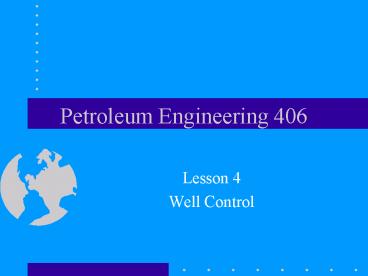Petroleum Engineering 406 - PowerPoint PPT Presentation
1 / 38
Title:
Petroleum Engineering 406
Description:
Maximize penetration rates with balanced drilling ... Paleontology. During Drilling. dc-exponent. P=K*(W/D)d*Ne. P=penetration rate of shale ... – PowerPoint PPT presentation
Number of Views:262
Avg rating:3.0/5.0
Title: Petroleum Engineering 406
1
Petroleum Engineering 406
- Lesson 4
- Well Control
2
Read
- Well Control Manual
- Chapter 9
- Homework 2 Due Feb. 3, 1999
3
Content
- Development of Abnormal Pressure
- Properties of Normally Pressured Formations
- Properties of Abnormally Pressured Formations
- Casing Seat Selection
4
Knowledge of Pore and Fracture Pressures Leads to
- More effective well planning
- Maximize penetration rates with balanced drilling
- Safer and more economical selection of casing
points - Minimize trouble due to lost circulation and kicks
5
Knowledge of Pore and Fracture Pressures Leads to
- Better engineered production and test equipment
- Better understanding of local geology and
drilling hazards - More accurate analysis of drilling data and
electric logs
6
Normally Pressured Formation
Fluids Squeezed out with compaction
7
Abnormal Formation Pressures
- Due to
- Incomplete compaction
- Diagenesis
- Differential Density in Dipping Formations
- Fluid Migration
- Tectonic Movement
- Aquifers
- Thermal Effects
8
Incomplete compaction
Fluids trapped in place
Fluids begin to support overburden
9
Diagenesis
- At 200oF to 300oF Clays undergo chemical
alteration. Montmorillonite clays dehydrate and
release some of the bound water into the space
already occupied by free water, increasing
pressure
10
Differential Density in Dipping Formations
11
Fluid Migration
12
Tectonic Movement - Uplifting
13
Tectonic Movement - Faulting
14
Aquifers
15
Thermal Effects
- Theories
- Increased temperature with depth and chemical
reactions cause increased pressures - Increased pressures caused increased temperatures
16
Salt Formations
Pressure Gradient
Depth
Pore press. gradient Overburden gradient
Salt formation
17
Shale Properties used to Predict Pore Pressures
- Shales are used because
- Most pressure transition zones occur in
relatively thick shales - Properties of clean shales are fairly homogeneous
at any depth, and can be predicted with some
degree of accuracy.
18
Shale Properties used to Predict Pore Pressures
- Shales are used because
- A deviation from the expected can be interpreted
as a change in pressure gradient - Detecting these deviations in low permeability
shales gives an early warning prior to drilling
into pressured permeable formations, thus
avoiding kicks.
19
Normally Pressured Shales
- Porosity - Decreases with depth
- Density - Increases with depth
- Conductivity - Decreases with depth
- Resistivity - Increases with depth
- Sonic travel time - Decreases with depth
- Temp. gradient - Relatively constant
20
Abnormally Pressured Shales
- Porosity - Higher than expected
- Density - Lower than expected
- Conductivity - Higher than expected
- Resistivity - Lower than expected
- Sonic travel time - Higher than expected
- Temp gradient - Increases
21
Porosity Density Conductivity Sonic
Shale Density
22
Temperature gradient - Increases
Depth
Normal Trend
Top of Geo-pressure
Temperature
23
Pore Pressure Prediction Occurs
- Prior to drilling
- During drilling
- After drilling
24
Before Drilling
- Offset mud records, drilling reports, bit
records, well tests - Geological Correlation
25
Before Drilling
- Open Hole Logs from offset wells
26
Before Drilling
- Seismic data
27
During Drilling
- Kick - SIDPP and HSP in DP can give accurate
measurement of formation pore pressure - LOT - gives accurate measurement of fracture
pressure
28
During Drilling
- Correlation of penetration rate to offset logs
- Changes in shale penetration rate
29
During Drilling
- Shale density Change
- Mercury pump
- Mud balance
- Fill mud balance with clean shale until it
balances at 8.33 ppg - Fill the balance cup with water and determine
total weight - Calculate shale bulk density
- SBD8.33/(16.66-Total Weight)
30
During Drilling
- Shale density Change - Density column
31
During Drilling
- Mud gas content change
32
During drilling
- Shale cutting change
33
During Drilling
- Mud chloride change
- Increase in fill on bottom
- Increase in drag or torque
- Contaminated mud
- Temperature change
34
During Drilling
- Abnormal trip fill-up behavior
- Periodic logging runs
- Drill-stem tests
- MWD or LWD tools
- Paleontology
35
During Drilling
- dc-exponent
- PK(W/D)dNe
- Ppenetration rate of shale
- Kformation drillability
- Wweight on bit
- Dbit diameter
- Nrotary speed
- dbit weight exponent
- erotary speed exponent
36
During Drilling
d-exponent and dc-exponent
37
During Drilling
38
After Drilling
- Log evaluation
- Flow tests
- BHP surveys
- Shut-in pressure tests
- Analysis of mud reports, drilling reports, and
bit records

